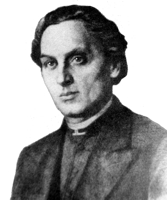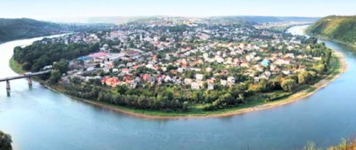
|
The Society of Folk Dance Historians (SFDH)
The Mermaid of the Dniester
[
Home |
About |
Encyclopedia | CLICK AN IMAGE TO ENLARGE |

|
 The Mermaid of the Dniester, published in Courier, Issue 3 (Mar 1989), p.23 by Osyp Petrash
The Mermaid of the Dniester, published in Courier, Issue 3 (Mar 1989), p.23 by Osyp Petrash
Excerpt: In 1772, Galicia, in the western Ukraine, became a part of the Austrian Habsburg monarchy. The people of the new province were severely oppressed and remained largly illiterate. Intellectual life was impoverished by the fact that no books were published in the Ukrainian language; only a rich tradition of folk songs and legends nourished the spiritual life of the people.
At that time a number of Slav peoples (Czechs, Serbs and Croats) were undergoing a national and cultural revival. The first indications of a similar revival also began to appear in Galicia. In 1833, a clandestine circle was organized in Lvov, the capital, with the objective of reviving the national culture of the Ukrainians of Galicia. Its founders were three friends, Markiyan Shashkevych (1811-1843), Ivan Vahylevych (1811-1866) and Yakiv Holovatsky (1814-1888). Instead of speaking German or Polish, as was the rule when societies held meetings, they used their native Ukrainian language, and discussed the culture and destiny of their people.
The activities of the Shashkevych circle constituted not only a literary phenomenon, but a social and democratic movement. Its greatest achievement was the publication of an almanac entitled Rusalka Dnistrouvaya ("The Mermaid of the Dniester"), which was the first collection of Ukrainian literature to appear in the western Ukraine.
Shashkevych prepared a collection of literary works and folk songs, originally entitled Zona ("The Dawif') and submitted the manuscript to the board of censors. As there was no censor of Ukrainian books in Lvov, Zoria was sent to Vienna, where Varfolomei Kopitar, the censor of Greek and Slav books, made positive comments on the manuscript but pointed out that it was "purely political" and sent it back to Lvov. Under the new title of Rusalka Dristrovaya, the almanac was then sent to the Hungarian censor at Pest. He allowed it to be published and 1,000 copies appeared in Buda in 1837. One factor which had helped to make publication possible was Holovatsky's friendship with the Serbian writer Georgi Petrovich and other leading figures in the Slav revival.
What were the contents of this almanac that the Habsburg authorities found so disturbing? Its 150 pages open with an epigraph by the Czech poet Jan Kollar: "Not sad eyes, but the hands of the worker bring hope." These words were meant as an appeal to readers not to give way to pessimism about the destiny of the people, but to work towards its cultural and national awakening.
ABSTRACT
The history of the "Rusalka Dnistrovaya" (Mermaid of the Dniester), an anthology of Ukrainian literature and folk songs published in 1837, figures in the Slav Renaissance.
DOCUMENTS
- Renaissance, a culture.
- Ukraine, a country.
This page © 2018 by Ron Houston.
Please do not copy any part of this page without including this copyright notice.
Please do not copy small portions out of context.
Please do not copy large portions without permission from Ron Houston.